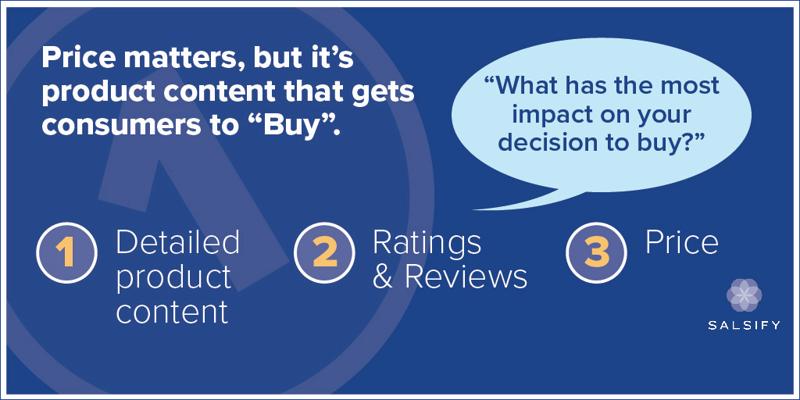A Buyer's Journey: How to improve ecommerce conversion rates


What's your customer's path to purchase?
The Takeaway: The average path to purchase ain't what it used to be. Digital channels now play a huge role in the buyer's journey, and that means you need to adjust how you treat ecommerce if you hope to improve ecommerce conversion rates.
Chances are that how you buy products today hardly resembles how you used to purchase items a decade ago. Unfortunately, however, many brands and retailers are still selling items like they were in 2006 - before smartphones were the norm and prior to Google demonstrating its impact on conversion rates in the ecommerce space.
Well, the buyer's journey has changed, as you've probably realized. But what exactly does the modern path to purchase look like? And how can you leverage that info to improve conversion rates? Let's dig in.
The buyer's journey detailed
The first leg of the buyer's journey starts with identifying a need: What product is your customer interested in purchasing and what are the criteria? For example, a sweater, possibly in a shade of blue and definitely not made of wool. This need could stem from marketing efforts or a personal decision - either way, it doesn't matter.
The second step in the path to purchase is research. Ninety percent of consumers go online to "shop," so your customer will browse for products and look for information on the Internet. The shopper's goal is to set a baseline expectation - it's a process of zeroing in on some key feature or characteristics of the best items in the specific product category.
 The buyer's journey is more complex than some may think.
The buyer's journey is more complex than some may think.Based on those expectations, your customer will overlay his or her personal needs, and that leads into phase three of this buyer's journey: the in-store experience. This shopper wants to be sure that they're making the right choice, and that often entails going to a physical store to touch, hold and examine products.
While in-store, your customer moves to the next stop on the path to purchase: the smartphone. Eighty-two percent of consumers use their phones while in-store to help inform their purchase decisions, according to Think With Google. That's because those shoppers and your customer have seen products in person, and now their decisions are getting easier. But first, this shopper wants to ensure the choice to buy is a smart one, and therefore, more info is required.
"Revenue from Google PLAs increased 52% YoY in Q1 2016."
Stop: Google search time
So, the consumer pulls out an iPhone and Google searches for your product. This is a critical phase in the buyer's journey and a key to conversion. Sidecar recently found that revenue from Google Product Listing Ads increased 52 percent in Q1 2016 compared to Q1 2015, with mobile PLA-based sales growing 164 percent. This is the phase of the buyer's journey where opinions are formed and final decisions are made.
The next step is to buy. Maybe your customer will buy in-store, or find a good deal online. Either way, the fact of the matter is that the secondary research phase is absolutely critical. So, the question now becomes "How can I influence the shopper's thoughts from the first time research is conducted to the last?"
Improving your conversion rates
That's where product content comes in. At the end of the day, product content - or lack thereof - influences purchase decisions. It's the No.1 criterion that inspires consumers to click "buy" - or not.
 Learn more from our latest consumer research report, "Cracking the Consumer Code."
Learn more from our latest consumer research report, "Cracking the Consumer Code."The point is simple: The more detailed, specific, accurate, consistent and engaging your product content is, the higher your conversion rates. Shoppers want in-depth descriptions, technical specs, ingredients, reviews, images, videos and much more. They demand at least three images and at least three reviews per product. That matters when your customers are in-store or buying online.
So, to improve your ecommerce conversion funnel, you need to ensure they can find that information. That entails injecting some SEO into your PLAs. (Check out our "Turning Google Searches into Sales" webinar and blog post for some more information on this!) It also means just getting product content into Google's hands - that's how you boost conversion rates on Google Shopping. The same goes for all ecommerce retailers, for that matter. You must give all of your retail partners the most accurate and up-to-date product info that you have.
Today's shoppers crave product content - whether they know it or not. It's the crux on which purchase decisions are made, and researching that info is a major step in the buyer's journey. So meet that need and give your customers the content they need to click "Buy" or head to a register.
Tag(s):
Omnichannel Commerce Strategy
Written by: Emily Saka
Emily Saka (she/her) is a former content marketing manager at Salsify, where she spearheaded the development of the company’s original content marketing strategy.
Recent Posts
Ecommerce Marketing
|
12 minute read
The Art of the Impulse Buy: 70% of Shoppers Say Discounts Drive Unplanned Purchases — Here’s Why
Read More
Ecommerce Marketing
|
10 minute read
What Does It Take To Have a Good Brand Reputation in 2025?
Read More
Ecommerce Trends
|
11 minute read
What Is Commerce Media — and How Can It Optimize Your Marketing Spend?
Read More
Subscribe to the Below the Fold Newsletter
Standing out on the digital shelf starts with access to the latest industry content. Subscribe to Below the Fold, our monthly content newsletter, and join other commerce leaders.


.svg)